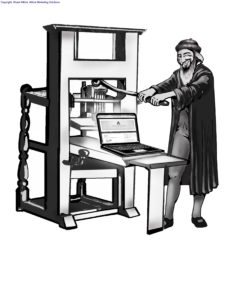
I have been reading Leonard Shlain’s fascinating book, The Alphabet Versus the Goddess: The Conflict between Word and Image. I wish I had encountered it before I had completed my now book. I have been referring to Iain McGilchrist for the last year or so as my primary source for the divided brain model, but Shlain has described the same dichotomy, using a completely different style, telling historic stories without adding any clinical data. I find his work just as compelling as McGilchrist’s.
In this book, Shlain traces the many shifts between the two brain hemispheres that have occurred over human history and their consequences on human societies. His basic argument is that alphabetic languages shifted cultures to masculine, left-brain dominated behaviors from feminine, image-based, right-brain patterns. The behavioral traits he ascribes to the two side of the brain are virtually identical with those that McGilchrist identifies. I am about two-thirds through and have just as many sticky page markers jutting out as I have put in McGilchrist’s book.
Shlain uses short chapters, each one describing a contrasting juxtaposition of left- and right-brain-related cultural characteristic and historic events. I am up to Chapter 32 in which he describes the horrendous witch hunts and cruel treatments of the “untold” women caught up in this craze that ran from the 15th to 17th century in Europe. Downplaying other explanations, he proposes; “that the witch craze was the result of the ballooning up of the left hemisphere’s hunter-killer attributes, which was inflated by the rapid expansion of printing press-generated alphabet literacy.”
One of the aphorisms at the head of the chapter is this quote from Marshall McLuhan: “Schizophrenia may be a necessary consequence of literacy.” Not to be undone, I had made a similar statement in my forthcoming book:
To set the stage for what I find is a stunning claim, the key feature of this model of the brain is that it presents not one, but two, distinct worlds to the acting, existing human being. We are truly, schizoid, acting as if we were split into two different people. How our individual lives and the character of our collective cultures turn out depend on which of these worlds tends to dominate. Flourishing depends on how those two worlds work together.
This chapter follows several that discuss the centuries of bloodshed in Europe that followed the Protestant Reformation, arguing that the popularizing of the Bible, plus the printing press and new sources of paper, produced an unprecedented rise in literacy, which is a left-brain function. Shlain points out that savage witch hunts savage were aimed almost entirely at women—men were rarely involved. The perpetrators were led by male religious leaders. Shlain asks “what to make of ‘religious’ leaders who claim that they alone have access to the ‘truth’ and [yet] sanction the murder of those who disagree with them?”
This left-brain attitude stands in opposition to the right-brain character of religious practices and of the founders of all the great world religions. He notes:
All [spiritual traditions] have developed exercises and rituals to alter everyday consciousness to transcend an individual’s feelings of alienation and reconnect (religare) that person to “the source.” The inner peace so generated enables a person to see oneself in the matrix of gender identity, and to intuit connections to all other living things. This insight engenders in the soul of one so graced both wisdom and compassion, two attributes that characterize every prominent ancient religious leader.
History has a habit of repeating itself. The dehumanizing of immigrants and non-white skinned persons that we are seeing right now in the US and other countries has the same left-brain dominating traits as did the earlier witch hunts and other attacks on the “Other.” It can’t be due to a rise in alphabet literacy, since that is almost universal, now. I already had looked for clues in my forthcoming book. One of the most likely culprits is a new form of modern literacy—the internet, digital devices, and social media. What an interesting parallel to the role played by the printing press.
Image: Thanks to Stuart Atkins